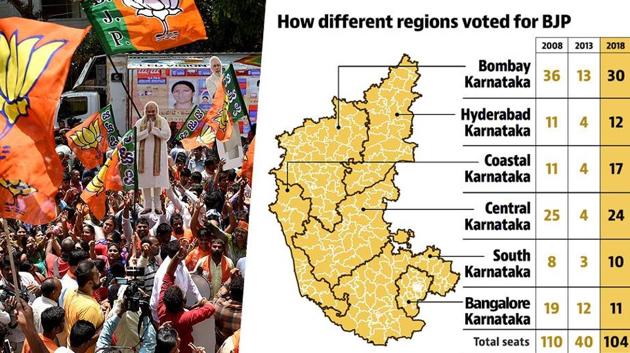A big Hindutva imprint in BJP’s Karnataka election performance
BJP’s current tally of 104 seats is six short of the 110 it got in the 2008 Karnataka elections. Its 2018 performance is worse than its 2008 performance in the Bombay Karnataka sub-region.
That the Bharatiya Janata Party (BJP) made a great comeback in the Karnataka elections is beyond doubt. It has increased its 2013 seat tally of 40 by 64. Several factors factors such as BS Yeddurappa bringing back Lingayat votes, a last minute boost from Prime Minister Narendra Modi’s rallies, a not so visible but nevertheless a big anti-incumbency wave against the Siddaramaiah government etc. have contributed to this performance. However, an analysis of the region-wise performance of the BJP from the 2008 to the 2018 elections shows that Hindutva might have been the biggest factor. Comparing 2008 with 2018 is a better idea because the BJP had suffered a lot due to defections in the 2013 elections.

The BJP’s current tally of 104 seats is six short of the 110 it got in the 2008 elections. Its 2018 performance is worse than its 2008 performance in the Bombay Karnataka sub-region. It is only marginally better in the Hyderabad Karnataka sub-region. The two regions contain a large part of the state’s Lingayat population . This shows that the party has not made any extraordinary gains due to the return of the Lingayat votes.
Even in Bangalore Karnataka, the deficit in BJP’s 2018 seats compared 2008 is eight seats. Elections have been deferred in two seats in the region but the party would still be in deficit if they managed to win both.
The region where the BJP made the biggest improvement in comparison to its 2008 performance is the Coastal Karnataka belt, where its seats have increased by 55%. This area is known for communal polarisation. This author had drawn attention towards the possibility of sharp communal polarisation in the state in an earlier piece published on 12 May, 2018. It said, “The only clear community-based polarisation, which one comes across in the state, is among Muslims. It goes beyond the communally sensitive region on the coast this time. Muslims, who admit to having voted for the JD(S) in previous elections, are explicit about voting for the Congress this time…To be sure, a consolidation of Muslim votes behind the Congress could also create a counter-polarisation behind the BJP.”
The fact that the BJP has made its biggest gains in the coastal region shows that it did gain from a counter-polarisation among non-Muslims.
Also read: Interactive map of the Karnataka election results






